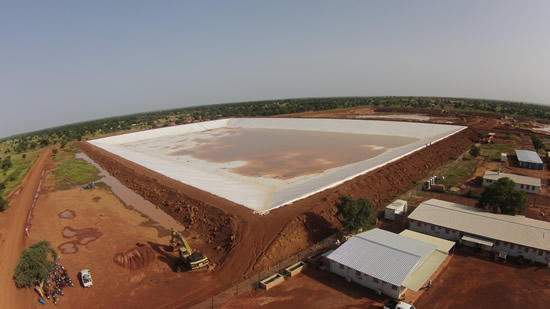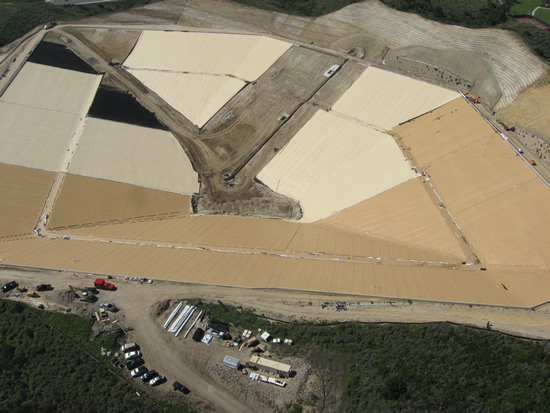


Geomembrane installations often cover substantial areas. Landfill cells pose enormous footprints. Oil and gas pits, industrial processing ponds, and wastewater containment ponds are large installations too, and each year they tend to be built a little larger. The scaling up of these facilities is not just a matter of achieving better operational economics for the facility owner; it’s also because geosynthetic materials perform well and strong installation practices continue to prove that another leap in project scale is attainable.
Alongside these changes to the scale of installations is the constant refinement that occurs in geomembrane manufacturing.
You can see the result of a major shift in manufacturing in many of the photos you might encounter from large lining projects. Increasingly, the materials are lighter. Instead of their traditional black color, they being specified and supplied in white, tan, and lighter gray shades.
ADVANTAGES OF LIGHTER COLORS
Lighter colored geomembranes provide some important advantages in a large installation. A solar-reflecting (white) surface reduces thermal expansion of the materials. Black liners that must be welded in the field (e.g., HDPE and LLDPE) require slack to be built into the system and the liners must be left to warm a bit in the sun before panel joining activities take place. The expansion that occurs, if not properly accounted for, could lead to wrinkles in the geomembrane system, which would subsequently pose an increased risk for damage or complicate detecting damage.
Also, when these geomembranes are installed over a geosynthetic clay liner (GCL) layer, the thermal fluctuations in a black geomembrane as it warms and cools while exposed can pull water from the soil beneath the geomembrane. This can incite a desiccation process in the GCL zone.
In better managing the impact of uv light, solar-reflecting layers can extend the life of a geomembrane by slowing surface degradation.
Furthermore, products with white layers atop black can help visually identify damage, as the black layer will show if the white surface is damaged.
Whether exposed only during the installation process or serving as an exposed liner, reflective geomembranes offer a number of practical benefits that can lead to real long-term performance advantages.
ARE THEY AS UV RESISTANT?
Carbon black is deservedly renowned for enhancing UV resistance in various materials, and it has been a major component of the success of geomembranes. But, carbon black isn’t used exclusively for surface stabilization against uv light; and there there are other ways stabilize materials.
Advances in the additive packages used in manufacturing have enabled producers to use custom formulations with light stabilizers other than carbon black on the surface. Quality control and testing programs, in-house and with independent verification, have helped manufacturers achieve the same strong UV resistance in the surface layer of these geomembranes without the need for carbon black.
The carbon black is still generally present. Co-extruded white HDPE and LLDPE geomembranes, for example, typically feature white surfaces (textured or smooth) and a core of black geomembrane that is thicker than the white surface layer(s).
Adding to the field record of HDPE and LLDPE geomembranes, lighter surface colors on CSPE geomembranes have decades of field performance, including in long-term exposure (e.g., floating covers).
EXAMPLES IN THE MARKETPLACE
High-density polyethylene (HDPE) and linear low density polyethylene (LLDPE) geomembranes are seeing significant growth for white liners. GSE Environmental (www.gseworld.com) has long produced a white geomembrane (GSE White) with its reflective surface.
The company also offers conductive white liner (e.g., High Performance GSE Leak Location Liner White). These materials come in standard thicknesses, such as 40 – 100 mil, and can utilize various electrical leak location methods to identify potential damage down to pinholes, including high-effective surveys of the bare geomembrane immediately after installation.
Abigail Beck (TRI Environmental, www.linersurvey.net) has found that the probability of a liner system exceeding the designed Action Leakage Rate (ALR) is 22.2% if no survey is performance; 7.1% if a dipole electrical leak location survey is performed; and 0.00001% if a bare geomembrane survey and a dipole survey are performed. A conductive geomembrane makes this possible.
Solmax (www.solmax.com) is another company that has invested well in white geomembranes. The company has been transitioning to more white geomembrane products. This has included a global campaign in early 2015 on “Getting out of the Dark”, as the company shift its production heavily to white geomembranes. The move is the result of both manufacturing advances and market demand.
The company’s White HDPE Series and LLDPE Series products use a co-extruded three-layer structure with reflective white surfaces on top and bottom and a core of black geomembrane. These products are being used in containment applications such as landfill capping, pond lining, secondary containment, exposed and temporary covers, mining, and others.
Agru America’s (www.agruamerica.com) white and black geomembrane series is available in HDPE and LLDPE types, as well as with the availability of smooth or texturing through the company’s noted MicroSpike surface for enhanced frictional characteristics.
Brawler Industries (www.brawler.com) offers an optional gray upper layer on its SuperScrim™ H Series geomembranes as an alternative between the white and black. The company has created the product to reduce heat buildup and reflective glare. The latter benefit is offered to improve visibility for site workers in very sunny climates. These materials are being used in reserve pits, frac pits, under rig liners, retention ponds, fresh water pits, flowback pits, secondary containment, aboveground storage tanks.
CSPE geomembranes from Burke Industries (www.burkeind.com) have shown used some creative pigments to better blend in with the environments in which they are installed. Green, tan, and even camouflaged designed have been used, all without increasing project cost or affecting liner performance. CSPE (still referred to by the old Hypalon brand by many) have a very rich record of exposed geomembrane performance. In areas in which covers are being required on reservoirs, CSPE has been extremely effective in reflecting light and resisting degradation for 20, 25, or 30+ years.
ADDITIONAL FEEDBACK
In addition to the strong support from manufacturers, installers, distributors, and other industry partners provide good resource materials that show why lighter colored geomembranes are being specified more frequently these days.
Installation companies like Colorado Lining International (www.coloradolining.com) can attest to how controlling the thermal expansion concern of membrane panels in the sun can benefit the installation overall. Installation work in general requires strong coordination by the installation team and any affiliated earth works and CQA on site. Minimizing a concern like potential thermally-induced wrinkles can go a long way towards making the installation more efficient.
**
Chris Kelsey is Geosynthetica’s international editor. A version of this article was previously published in Land and Water Magazine, www.landandwater.com.












Excellent article! Info appears useful and correct. Pleased to see the aerial pic of the Upper Chiquita Reservoir Liner and Floating cover, for which I had the honor to serve as the design sub-consultant to AECOM.
Thanks for the comment! The Upper Chiquita project is fine work. I got to write about it not long after it was completed and it has stayed with me. When I found opportunity to revisit it, as I have here, I do. It’s a fantastic example.